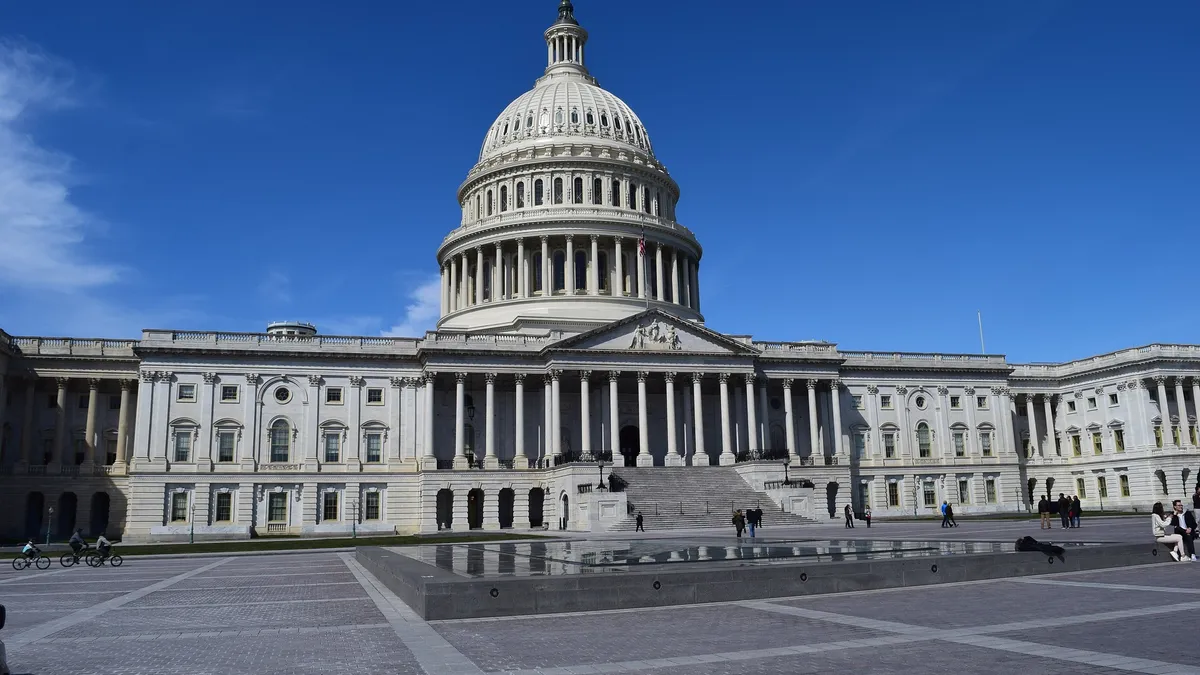Dive Brief:
-
House Democrats unveiled legislation on Tuesday that would bring economy-wide greenhouse gas (GHG) emissions to net-zero by 2050, and cut emissions 50% below 2005 levels by 2030 or sooner.
-
The CLEAN Future Act proposes a national Clean Energy Standard that would require all retail electric providers to generate 100% of their power from zero-emissions resources by 2035, and 80% by 2030. It would also require the Federal Energy Regulatory Commission to update U.S. transmission policy in order to better integrate renewables onto the grid, and direct greater investment in energy storage, microgrids, distributed energy resources and more.
-
The bill also targets transportation electrification, environmental justice, economic transition for fossil fuel workers, building efficiency and more. It would also include major changes to the Federal Power Act (FPA) and the Public Utility Regulatory Policies Act (PURPA).
Dive Insight:
Tuesday's bill is the latest in a series of clean energy infrastructure plans that House Democrats have put forward over the past year — most recently, the bipartisan companion bill to the Senate's American Energy Innovation Act that passed last year as part of a broader COVID-19 relief package. And last summer, House Democrats pushed forward the GREEN Act that aimed to boost federal tax incentives for solar, storage, offshore wind, electric vehicles and more.
The CLEAN Future Act was first proposed as a draft last January, but adds critical labor protections in its latest iteration, requiring prevailing wages for construction of new generating units. "These are very important labor protections," said Leah Stokes, an assistant professor at the University of California, Berkeley, focused on climate and energy policy, in a tweet.
The bill is focused in part on bringing the power sector to 100% carbon-free power by 2035, a commitment President Joe Biden made on the campaign trail.
In order to do that, the legislation would direct retail power providers to begin generating more of their power from clean energy resources, starting in 2023, including through clean energy credits. States would manage their own plans to meet the 2050 goal, if approved by the Environmental Protection Agency.
It would also significantly reform federal energy regulations under FERC and the Department of Energy by lowering barriers to interstate transmission buildouts, establishing an Office of Transmission under FERC and requiring the commission to reassess current transmission policy.
The bill would establish "that it is the policy of the United States that a modern transmission system should facilitate a decarbonized electricity supply to enable GHG emissions reductions, and that the public interest is served by reducing barriers to transmission investments that enable clean energy resources deployment."
Further, the bill would amend the FPA by requiring all public utilities to place transmission facilities under the control of an independent system operator or regional transmission organization within two years. It would also amend PURPA to require states to invest in energy storage systems, establish a standard directing utilities to consider non-wires alternatives to traditional transmission, and have utilities offer community solar programs to all ratepayers.
Building codes would require zero-energy-ready buildings, or buildings that produce enough renewable energy to meet their own annual energy consumption requirements, for new and existing buildings by 2030. The bill would also direct investments toward electrifying transportation and building out charging stations to support a larger fleet of electric vehicles.
"Today's introduction of the CLEAN Future Act promises that we will not stand idly by as the rest of the world transitions to clean economies and our workers get left behind, and that we will not watch from the sidelines as the climate crisis wreaks havoc on Americans' health and homes," said Energy and Commerce Chair Frank Pallone, D-N.J., in a statement.
Pallone, along with Environment and Climate Change Subcommittee Chairman Paul Tonko, D-N.Y., and Energy Subcommittee Chairman Bobby Rush, D-Ill., introduced the bill, which is the result of 27 hearings on the climate crisis over the past two years, according to the E&C Committee.
Although Democrats narrowly control both chambers of Congress, the legislation is unlikely to pass with the 60 vote threshold it would need in the Senate, nor would it pass through budget reconciliation, said Stokes, "and it wasn't designed to do that."
"But it's wonderful to see this strong leadership from House Democrats saying that 100% clean power by 2035 is within our reach!" she added in a tweet.













